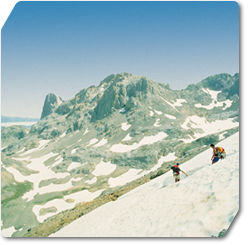- Villa search

- Canaries
- Caribbean
- Croatia, Bulgaria and Hungary
- Cyprus
- Florida
- France and Corsica
- Greece
- Italy
- Lakes and Mountains
- Madeira
- Malta and Gozo
- Portugal
- South Africa
- Spain - Balearics
Information
Travel News: Spain

It is, perhaps, in the Cordillera Cantabrica in Asturias that you can best experience one of the last corners of truly wild terrain and a culture where the old ways, the old superstitions, survive intact. The absence of roads has for centuries left this area remote and untamed.
Incredibly, wolves still roam the forests and bears, too – both so isolated from the populations of central Europe that they have evolved into a separate Spanish species.
Asturias is now fighting to save the few dozen remaining wild bears and has funded a special project to protect them. But their future remains precarious. Despite an act banning it, bear hunting continues. Snares and traps are still laid as farmers declare their right to keep the animals off their land despite compensation from the regional government for any damage caused.
At Proaza, Tola and Paca the offspring of a bear slaughtered by hunters now live in a protected area but can return to the wild on special walkways. A nearby museum, the Casa de Oso, is actively campaigning for new protection. But the conflict of interests has yet to be resolved.
There are no longer bears or wolves in the Picos de Europa. This range of soaring peaks, limestone gorges, lakes and flower-filled meadows – arguably as lovely as any of the alpine areas of Europe – is more accessible for tourists, and under more pressure from them.
A rail link to the isolated village of Bulnes, previously only accessible by donkey track, caused vociferous outrage among Spanish environmentalists. The opening up of new roads with European money is making the mountains busier. Yet shepherds still produce cheeses in the mountain pastures, farmers walk their cattle to summer grounds and scythe hay in the meadows. In many of the small villages a traditional way of life still endures.
The Picos national park is a flower-filled paradise, but you don't have to be a mountain climber to experience the glorious meadows or the limestone rock gardens. There are walks to suit every ability that take you into the heart of the massif.
It isn't uncommon to see chamois just a short walk from the crowds of the cable car station at Fuente De. Despite a rotten head for heights, I have walked the spectacular Cares Gorge several times, negotiating hairpin bends under rock overhangs hundreds of feet above the river. Each time, surprisingly, I found myself more preoccupied with the sight of griffin vultures and eagles circling overhead, or watching the elusive salamandras, than the drop below.
home | destinations and editorial | villa search | property for sale | car hire | flights | services
villaseek blog | contact villaseek | links and resources | advertise your villa© Dune Root Ltd and Villaseek.com 2012 - Caribbean
- Canaries